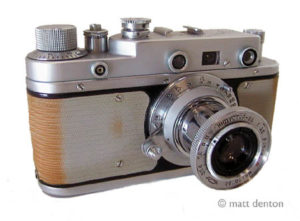 At first I just didn’t get it. It wasn’t until I bought my first one and tried to use it that I understood what a rangefinder was and why it was special. I was used to SLRs where you see through the lens itself, and to point-and-shoot cameras and their lousy viewfinders. Picture the viewfinder with a focusing mechanism in it and you have a rangefinder. It uses a second window and a clever mirror trick to approximate human vision and the way we focus our eyes.
At first I just didn’t get it. It wasn’t until I bought my first one and tried to use it that I understood what a rangefinder was and why it was special. I was used to SLRs where you see through the lens itself, and to point-and-shoot cameras and their lousy viewfinders. Picture the viewfinder with a focusing mechanism in it and you have a rangefinder. It uses a second window and a clever mirror trick to approximate human vision and the way we focus our eyes.
Not having a flip-up mirror allows rangefinders to be quiet, making them the traditional street photography tool. With the advent of leaf shutters in the mid-Sixties, they became extra quiet. The Seventies brought electronics to make them smaller and smarter, with CdS metering and auto exposure on many models, and even autofocus. Many of these later models relied on dependable but now largely extinct mercury batteries, for which luckily some equivalent replacements still exist. However, the better ones have the option to act in full manual mode, and the older ones are strictly mechanical so no battery needed!
Rangefinders’ popularity waned with the rise of SLRs in the Seventies and Eighties, SLRs being versatile and easy-to-use and having their own increasingly sophisticated electronics (grid focusing, what?). But rangefinders seem to be currently enjoying a secret renaissance, coming now as a sophisticated alternative to point-and-shoot cameras with some of their ease of use, but without the bulk of an SLR system.
To make room for the classic XA2 and others, I’ve opened this section up to classic compacts, of which there are indeed some. As if this section wasn’t big enough already!
If you have information to add or would like to ask questions about these cameras, their use or care, or even just want to say ‘hey’, feel free to email me, I always enjoy hearing from you!
Rangefinders & Compacts Sample Image Gallery
Related Links
- The Living Images Virtual Camera Museum has nice pics and descriptions
- Guide to Classic Cameras
- Classsic Camera Profiles
- Classic Camera Manuals Page is a lifesaver
- Another great page of classic camera manuals from F and S Mariott
- A nice guide to focusing rangefinder cameras
- And while we’re at it, a primer to mentally calculating exposure
- And don’t forget my special page devoted to relubing Industar-26 and Industar-61 lenses